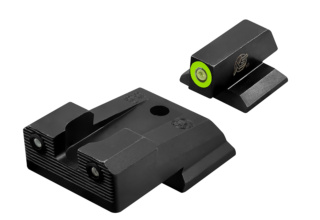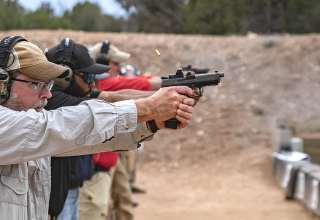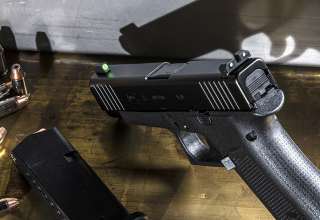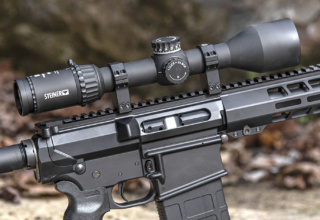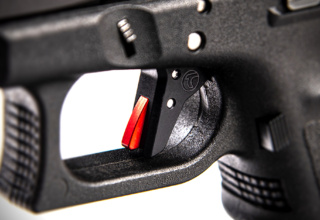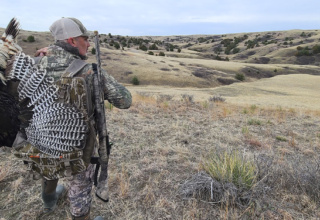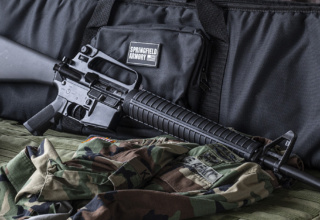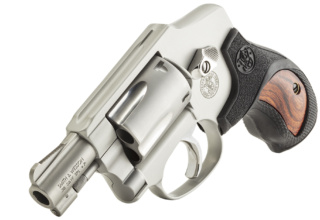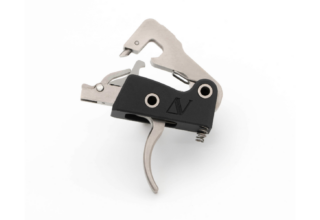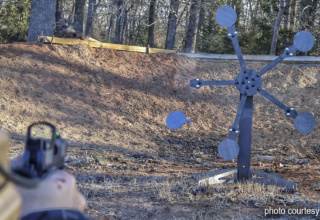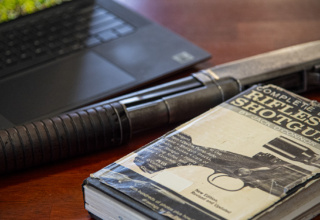Don’t get us wrong…we’re big fans of striker-fired semi-autos for just about every occasion, except for hunting, of course. Yet there’s something about the old-school charm and solid mechanics of a revolver that keeps them in our orbit, be it for no-fuss everyday carry or just to shoot something different on the range. And we’re not the only ones in that crowd. Witness the continued popularity of the many “snubbie” wheel guns from Ruger, Smith & Wesson, and Taurus.
Kimber America, a manufacturer that, traditionally, in no way comes to the fore of any discussion involving revolvers, recognized that a large contingent of firearm enthusiasts still appreciate wheel guns of high quality for various applications, including personal protection. Having built a well-deserved reputation in the handgun community for producing premium full-frame 1911s as well as micro .380s and 9mms for EDC practitioners, it was only a matter of time before the company cast an eye towards revolvers.
In 2016, Kimber did just that when it introduced the K6s. This represented a completely new handgun platform for the company—one that made consumers and the gun media take notice.

The K6s builds on the concept of purpose-engineering. In other words, the designers started with a fresh sheet of paper in developing this handgun, keeping four important parameters front-and-center: concealability, ease of carry, premium construction, and maximum performance; in this case, performance intending to deliver six rounds of .357 Magnum as opposed to the typical five rounds of conventional small-frame, short-barrel defensive revolvers.
Introduced with a concealed hammer, double-action-only firing system, the K6s is a well-rounded defensive pistol—literally. Crafted from stainless steel, the K6s hasn’t a sharp corner anywhere except for the sight edges, which is exactly what we want for a smooth, snag-free draw from underneath clothing. It’s also compact, with a thin 1.39-inch width and 7.62-inch overall length in the 3-inch barrel configuration.
Having been well-received from the outset, and with follow-up models introduced since the revolver’s debut (variations in grip material, finishes, and sight options), it came as no big surprise when Kimber released an exposed hammer version of the K6s earlier this year.
Dubbed the K6s (DASA), this latest revolver from Kimber continues all the features and sexy styling of the original K6s but comes with a traditional spurred hammer for those who prefer the option of shooting double-action or single-action.
First Impressions
Right away, the K6s (DASA) informs you of its up-town persona. The stainless steel—comprising the frame, cylinder, and barrel—is exquisitely brushed to a lustrous matte finish that’s just shy of being polished. The appearance is likened to a grey/silver that, when combined with the smooth curves, knocked-down edges, and thin seam lines, immediately calls to mind fine, hand-machined metal work. That same spirit of craftsmanship continues to the revolver’s rich walnut grips. Again, there are no crisp edges or hard angles to disrupt the flowing lines between wood and metal. And as with the stainless steel, the walnut features a light matte finish.

The best way for us to describe the feel-in-hand is silky. The handle contouring is such that even the flat of the serrated backstrap tactilely blends with the grip to go completely unnoticed. The other thing you’ll acknowledge is the “two-and-a-half finger grip.” Kimber calls this a three-finger grip, and it technically is for medium- and smaller-hand shooters. When you hold the revolver in the ready position with your trigger finger extended along the frame, though, you’ll note that the pinky finger is grasping the lower edge of the grip. In fact, the decreasing radius of the lower grip on all sides makes for a slender feel, and certainly contributes to the revolver’s minimal printing when worn concealed. It also hints to the experienced handgunner that this is a two-hand shooter when loaded with .357 Magnums.
When we picked up the K6s from our dealer, the first thing he said to us was, “It feels a bit nose-heavy.” The fact is, the K6s is not “nose-heavy” but rather quite well balanced. It’s just that the narrowing grip makes the revolver feel like wants to squirt out of your hand and tip forward. That feeling goes away once you wrap your finger around the trigger, which is another highlight feature of this revolver.
The trigger reach is spot-on for medium-size hands. Large-hand shooters will find the dimensions “compact,” while those with smaller hands will appreciate the leverage the shorter reach gives them. Another plus with the trigger shoe is its deep curvature and generously radiused edges. All of this combines to give positive, comfortable trigger finger placement and plenty of leverage to pull through when shooting in double-action mode.
Another welcome touch and a nod to improved ergonomics is the cylinder release. After an extended shooting session, the tip of your thumb can become quite raw from repeatedly pushing against the serrations of a conventional cylinder release—especially those revolvers with an exceptionally stiff release. The K6s release is more like a push-button that moves in toward the frame to release the cylinder instead of being pushed toward the cylinder. This makes popping the cylinder quick, easy, and painless. There is plenty of positive retention, though, so you don’t have to worry about accidentally unlocking the cylinder while holstering or carrying.

Speaking of the cylinder, this is where Kimber engineers managed to squeeze out a 6-round capacity. Where the typical revolver cylinder is generally round with concave recessing (flutes) between the chambers, the K6s cylinder fluting is shallow and flat and the usually rounded contours paralleling the cartridges are also quasi-flat. The latter, no doubt, contributes to the K6s’ slim width.
We also found the cylinder to be jewel-like smooth. Often, the revolvers we handle have too much slop in the ejector assembly for our tastes. If you don’t depress the rod perfectly straight, many tend to hang up when ejecting. We find no such issues with the K6s. The cylinder spins smoothly on the ejector rod and the crane closes the cylinder with precision.
Moving to the barrel, we find a one-piece unit available in 2-inch or 3-inch lengths. Kimber chose to go “beefy” with the barrel contour, keeping the sides flat and tapering them at the bottom. It’s extra weight when compared to a more rounded barrel contour, but that added heft surely helps to some degree in recoil dampening, and it provides a protective shroud for the ejector rod, thus eliminating another potential snag area.
Topping the barrel is a white dot front sight. This isn’t machined into the barrel, as is the case with many snubbies, but is a black steel sight that’s pinned to the frame. The rear sight is also black with white alignment dots. It sits in a dovetail machined into the frame. A set screw in the center of the sight conceivably allows for windage adjustment, however, the elevation is fixed. A serrated ramp at the back of the sight helps reduce glare. The notch is squared instead of U-shaped, which works well in high ambient light. We noticed in lower light conditions that we relied more on the front and rear dots to achieve sight alignment.

Interestingly, tritium sights are not an option on the K6s (DASA) although they are available on some of the concealed hammer K6s models. We expect this to be offered in the future.
On the Range
The .357 Magnum packs a good punch regardless of the revolver platform you are shooting. Load them in a compact wheel gun and it’s hard not to approach the firing line with a preemptive wince. Since we didn’t know what to expect with the K6s, the wincing came easily but proved to be unnecessary.
Shooting in single-action mode on the bench to establish general accuracy, the K6s exhibited the expected authoritative recoil, but nothing extraordinarily harsh for a revolver of this size. What did put a grin on our face was the trigger. Imperceptible trigger travel in SA mode and a break as crisp as a bright fall morning. Shooting at 15 yards, we managed a best 1.184-inch 5-shot group shooting 158-grain Aguila semi-jacketed soft points.
Satisfied with the K6s’ accuracy and the factory sight settings, we moved off the bench to evaluate real-world defensive shooting performance, shooting in both single-action and double-action modes.
The grips include diamond-checkering in the walnut panels and slight serrations in the steel backstrap. Good thing, because the reduced profile along the bottom of the grip does want to throw that third-finger purchase on recoil. A solid two-hand grip keeps the recoil manageable and the sight picture re-acquisition at an acceptable speed, but the grip—as comfortable as it is—offered a three-finger hold only for the first shot. After that, subsequent shots moved our pinky beneath the grip. That little finger continued to wrap around the grip, just along the bottom and not up front with the rest of our fingers. Still, we could manage full muzzle control for all six shots without having to readjust our grip.

As for harshness, hey, it’s a .357 Magnum, and no one is going to put in a couple hours of shooting without feeling it.
That, of course, is not the point of a compact big-bore revolver. The point is to deliver decisive threat-stopping power downrange until the threat has been neutralized or the cylinder is empty. The .357 Magnum is intended to get the job done on the first shot, and the Kimber K6s (DASA) will make sure that happens.
Kimber K6s (DASA) Specifications
Chamber: .357 Magnum
Capacity: 6 rounds
Action: DA/SA, non-stacking trigger
Trigger Pull (DA): 9.5-11.5 lbs.
Trigger Pull (SA): 3.25-4.25 lbs.
Frame Material: stainless steel
Frame Finish: brushed
Barrel Length: 3 in.
Barrel Material: stainless steel
Barrel Finish: brushed
Sights: white 3-dot
Sight Radius: 5.1 in.
Grips: walnut, 3-finger w/diamond checkering
Height: 4.46 in.
Weight w/Empty Cylinder: 25.1 oz.
Length: 7.62 in.
Width: 1.39 in.


